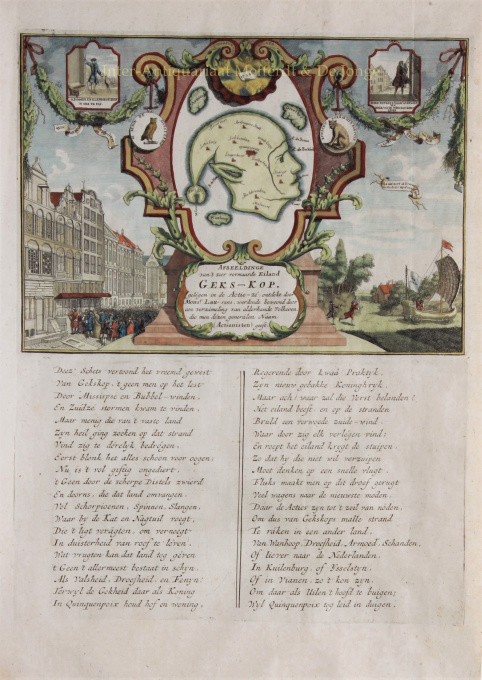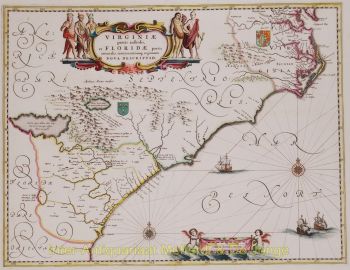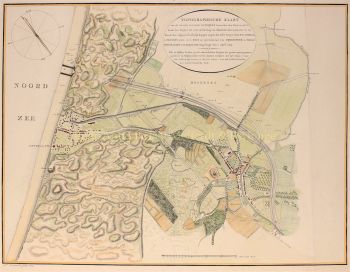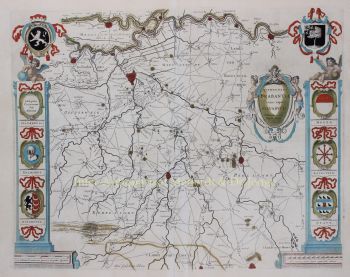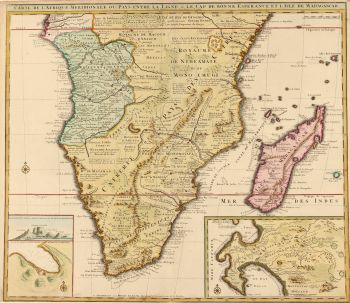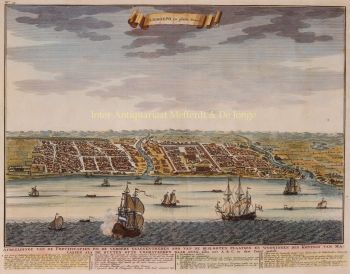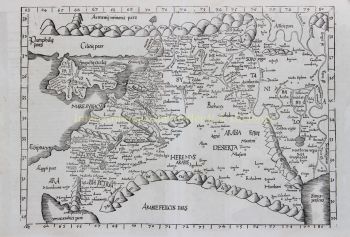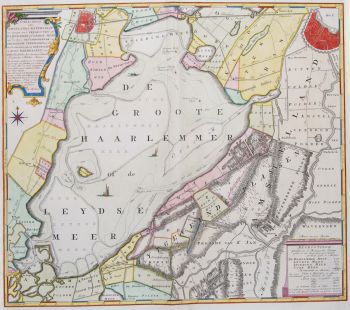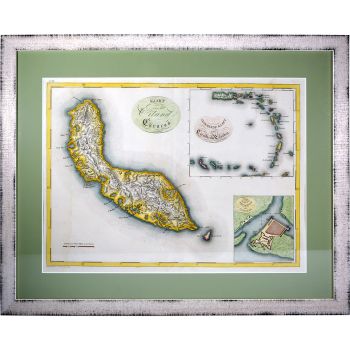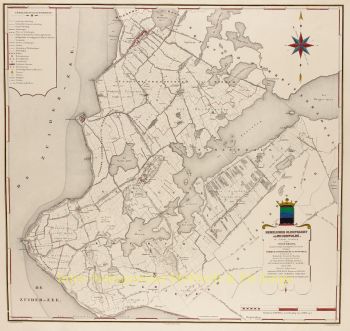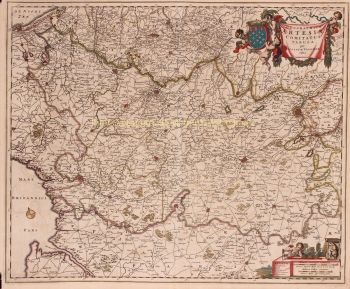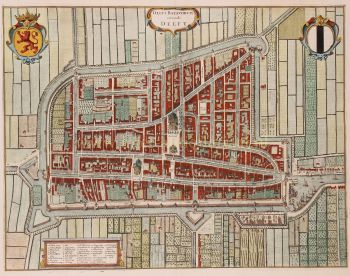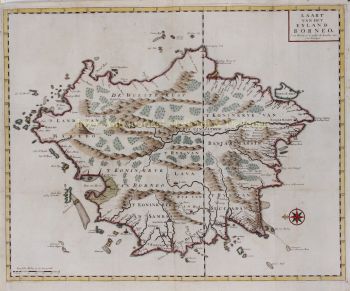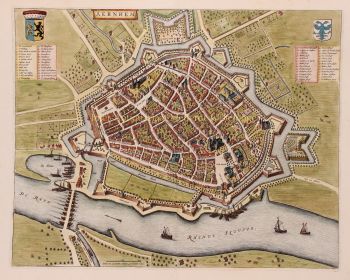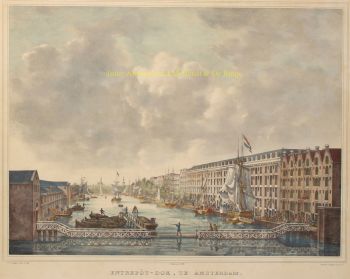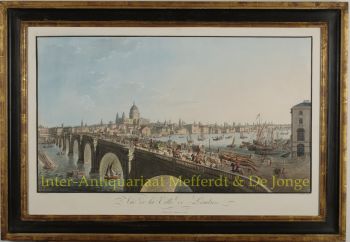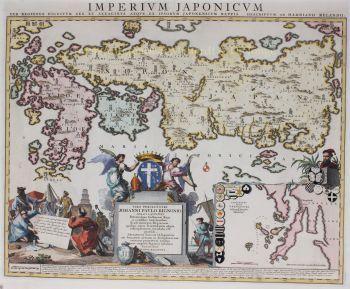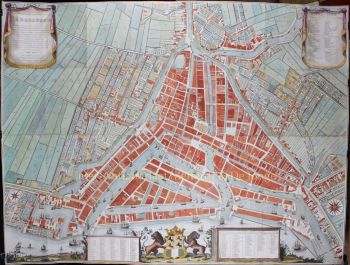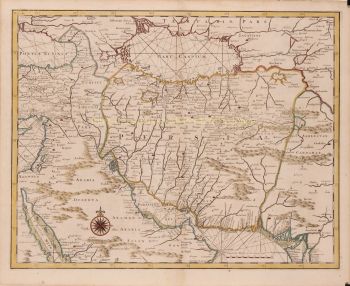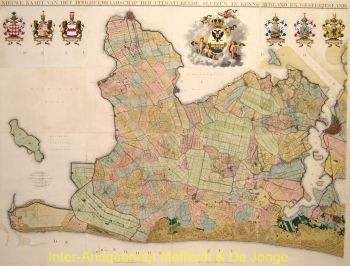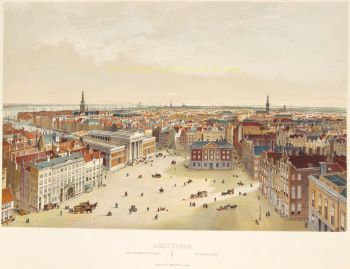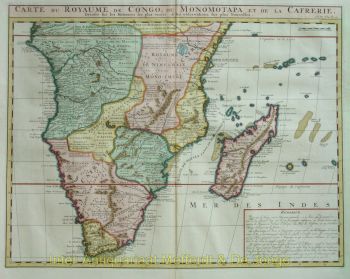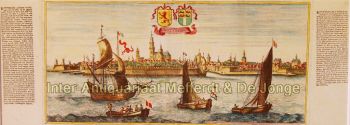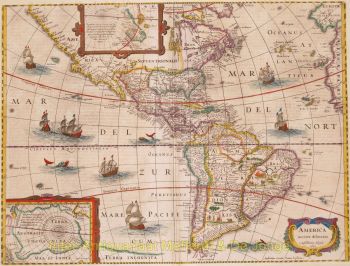Bolha do Mississippi, a Ilha da Cabeça-Louca 1720
Artista Desconhecido
€ 1.250
Inter-Antiquariaat Mefferdt & De Jonge
- Sobre arte“Afbeeldinge van't zeer vermearde Eiland Geks-Kop…”, [Representation of the very famous island of Mad-head, lying in the sea of shares, discovered by Mr. Lawrens, and inhabited by a collection of all kinds of people, to whom are given the general name shareholders.] Copper engraving anonymously engraved and printed in or after 1720 in Amsterdam for Het Groote Tafereel der Dwaasheid… The print satirizes the folly and consequence of the bubble economy created by the Mississippi Scheme and its careless investors. Size 29 x 23 cm. This satirical engraving of the Mississippi Bubble is one of the most famous cartographic curiosities. It represents the collapse of the French Compagnie de la Louisiane d'Occident, founded by the Scottish financier John Law in 1717, which was granted control of Louisiana. Its plans to exploit the resources of the region (the “Mississippi Scheme”) captured the popular imagination and people rushed to invest: share prices opened at 500 livres, but rapidly rose to 18,000 livres. At this point speculators indulged in profit-taking, causing a run on the shares. Confidence collapsed, causing a run on the company’s capital and the company went bankrupt, ruining many, not only in France, but throughout Europe. As a consequence of this failure, confidence in many colonial schemes collapsed, forcing many companies into bankruptcy, including the English South Sea Company and a number in the Netherlands, prompting this satire. The center of the map is an island that takes the form of a traditional fool’s head. It is situated in the “Sea of Shares”, surrounded by the smaller islands of Armoed [Poverty], Droefhyt [Sorrow], and Wanhoop [Despair]. Rivers are used to define the face, the cap, and the donkey ears, and are marked with humorous place names including Bedriegers Stadt [Charlatan City], Leugenburg [Lie Town], Blind Voort [Blind Fort], Sottenburg [Crazy Town], and Bederfwyk [Corrupt Quarter], among others. At the center is the city of Quinqumpoix, named after the street in Paris where John Law maintained his offices. The rivers Seine, Teems [Thames], and Maas [Meuse], are major arteries in those countries most affected by the collapse: France, England, and The Netherlands, respectively. A vignette to the left of the map illustrates angry investors storming the Quincampoix coffee house where stock exchange traders met in Amsterdam. In another to the right, John Law himself flees from angry investors in the direction of Vianen on board a square-rigged land-yacht, itself another absurdity of the period. The map shares the sheet with a second plate, situated below it, that continues to satirize the Mississippi Scheme in verse. Price: EUR 1.250,-
- Sobre artista
Pode acontecer que um artista ou criador seja desconhecido.
Algumas obras não devem ser determinadas por quem são feitas ou são feitas por (um grupo de) artesãos. Exemplos são estátuas dos tempos antigos, móveis, espelhos ou assinaturas que não são claras ou legíveis, mas também algumas obras não são assinadas.
Além disso, você pode encontrar a seguinte descrição:
•"Atribuído a …." Na opinião deles, provavelmente uma obra do artista, pelo menos em parte
• “Estúdio de…” ou “Oficina de” Em sua opinião um trabalho executado no estúdio ou oficina do artista, possivelmente sob sua supervisão
• "Círculo de ..." Na opinião deles, uma obra da época do artista mostrando sua influência, intimamente associada ao artista, mas não necessariamente seu aluno
•“Estilo de…” ou “Seguidor de…” Na opinião deles, um trabalho executado no estilo do artista, mas não necessariamente por um aluno; pode ser contemporâneo ou quase contemporâneo
• "Maneira de ..." Na opinião deles, uma obra no estilo do artista, mas de data posterior
•"Depois …." Na opinião deles uma cópia (de qualquer data) de uma obra do artista
• “Assinado…”, “Datado…” ou “Inscrito” Na opinião deles, a obra foi assinada/datada/inscrita pelo artista. A adição de um ponto de interrogação indica um elemento de dúvida
• "Com assinatura ….”, “Com data ….”, “Com inscrição ….” ou “Tem assinatura/data/inscrição” na opinião deles a assinatura/data/inscrição foi adicionada por outra pessoa que não o artista
Você está interessado em comprar esta obra de arte?
Artwork details
Related artworks
Artista Desconhecido
Uma rara filigrana a taça retortoli1550 - 1600
Preço em pedidoPeter Korf de Gidts - Antiquairs
1 - 4 / 12- 1 - 4 / 24
- 1 - 4 / 12

